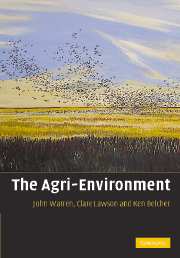Book contents
- Frontmatter
- Contents
- Preface and Acknowledgements
- 1 An introduction to agro-ecology
- 2 Agricultural support and environmentalism
- 3 Environmental impacts of agriculture
- 4 Principles behind agri-environment schemes
- 5 Farm conservation planning
- 6 Habitat management
- 7 The management of agricultural wastes
- 8 Low-impact farming systems
- 9 Landscape and farmscape ecology
- 10 The future of agri-environmental systems
- Glossary
- References
- Index
1 - An introduction to agro-ecology
Published online by Cambridge University Press: 08 December 2009
- Frontmatter
- Contents
- Preface and Acknowledgements
- 1 An introduction to agro-ecology
- 2 Agricultural support and environmentalism
- 3 Environmental impacts of agriculture
- 4 Principles behind agri-environment schemes
- 5 Farm conservation planning
- 6 Habitat management
- 7 The management of agricultural wastes
- 8 Low-impact farming systems
- 9 Landscape and farmscape ecology
- 10 The future of agri-environmental systems
- Glossary
- References
- Index
Summary
Introduction
Agriculture, the cultivation of plants and domestication of animals by humans, is approximately 10 000 years old. In evolutionary terms this should be an insignificantly short period of time, but it has not been. Human agricultural activity has changed the world completely; the genotypes of domesticated species have often changed beyond recognition. The relative abundances of species on earth have been altered dramatically, so that previously uncommon weedy grasses (cereals) now dominate vast areas. Even the habitats occupied by wild species have frequently been modified so they now support entirely novel communities of plants and animals. Natural communities from late in succession have been replaced by communities with ecologies more typical of early succession. The move from hunter-gathering to farming has allowed the human population to rise to more than six billion and therefore everything that humans do, every impact that we make on the planet, can be considered as an indirect environmental impact of agriculture. However, the scope of this book is less ambitious as it covers the more immediate direct interactions between agriculture and the environment. The function of agriculture is to direct energy from the sun (including fossil sunlight) into the human food chain. Little of this energy that is utilised by humans is then available for the other inhabitants of our planet. This process involves a great deal of effort to convert natural habitats into agricultural ones and replace wild species with domesticated ones, while natural ecological processes are exerting pressure on the system in the opposite direction.
- Type
- Chapter
- Information
- The Agri-Environment , pp. 1 - 18Publisher: Cambridge University PressPrint publication year: 2007



